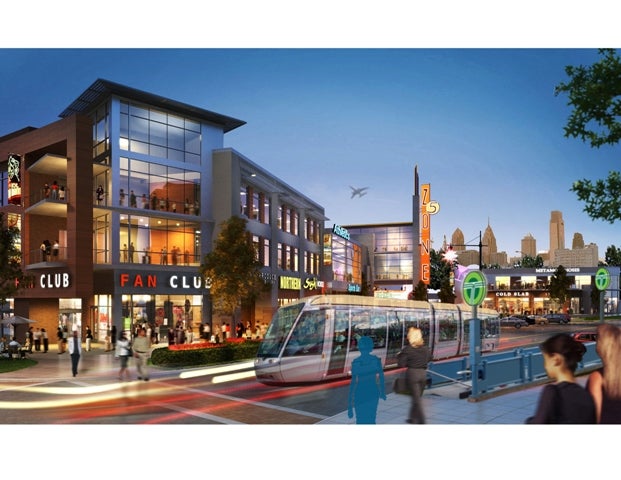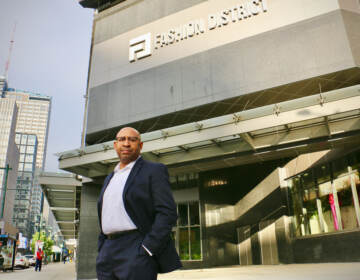Philadelphia: A Vision of 2040

June 9
By Julie Thompson
For PlanPhilly
Picture the city of Philadelphia today. Myriad familiar sites probably come to mind—Rittenhouse Square, City Hall, 30th Street Station, the Italian Market—places that have shaped the image of the city both here and in the eyes of the world. Now imagine the city in the year 2040. What will it look like? How will it have changed? Where will people live, work, and play in thirty years? And how do we get there from here?
As a native Philadelphian, it was as tantalizing an offer as any I could have imagined: the chance to create a Philadelphia of the future, moving confidently into the twenty-first century, yet keeping its best and most loved attributes of today. Unbelievably, this was no mere offer—it was the task at hand for 34 city planning graduate students. And we had five months to complete it.
The directive we had been issued seemed fairly straightforward: envision the best possible future, then work backwards to create concrete steps for reaching that goal. As part of the University of Pennsylvania’s studio entitled Philadelphia Futures 2040, however, the challenge was far from simple, or easy.
Our group devoted the last five months of the program to examining Philadelphia as a whole, imagining it as it could be in thirty years, and proposing actions for how it could emerge as a stronger, more vibrant version of the place we live now. One of three themes directed the groups of ten to twelve students throughout the semester: the Global City, the Green and Mobile City, and the City of Neighborhoods. The client for a project of such immense proportions was none other than the city of Philadelphia itself, represented by deputy mayors Andy Altman, Rina Cutler, and Mark Alan Hughes, and city planning director Alan Greenberger.
Over the course of the semester, the studio created three separate but interconnected visions for the city of Philadelphia in 2040. Taken together, they form a challenge to the city and its people: imagine a better place, then work to build it.
Creating a vision
Proposed by city planning department chair John Landis as the subject of a second-year studio project, Philadelphia 2040 was originally spurred by Mayor Michael Nutter’s charge in his speech about planning of June of 2008: to bring planning back as a vitally important part of city governance. Landis took this charge seriously, and thought of how best to answer that call through innovative, game-changing planning practices. The result came six months later, when the studio and its vision planning process was born.
Vision planning, a relatively recent type of approach, allows participants to create strategies for the growth, development and change that occurs in cities not only based on trends and data, but on ideas of how the city should physically exist in the future. By looking more closely at a city’s potential and the goals its people and leaders have for it, planners go farther than predicting the future; they can actually shape it.
Within the three groups in the studio, this compelling idea had the power to make people take risks, imagining possibilities for the city that traditional planning might have forced us to leave behind.
Speed bumps
Along the way to creating a coherent image of Philadelphia thirty years from now, reality often intervened to remind us of just how gargantuan—and complex—our job really was. The studio group spent a day driving through nearly every neighborhood in Philadelphia, taking in the incredible variety of urban forms that give the city its unique character, as well as some of its more intractable problems. Areas such as the Northeast, where few neighborhoods have many viable public transit options, struck a number of students as places that could benefit from long-term planning that incorporates not only transit services, but others such as neighborhood-serving retail as well.
Such was the motivation behind the City of Neighborhoods group’s Metro Centers concept. “We wanted to create places for people to go, and make it easy for them to get there. Basically, the goal is to create hubs of activity within the city that have retail, housing, and jobs, all in one central location. Philadelphians won’t have to rely on going just to Center City for work and play. They’ll have the option to work and live throughout Philadelphia, and the freedom to choose among many desirable places,” says Christy Kwan, MCP ’09 and a member of the Neighborhoods group.
Other strategies designed to improve Philadelphians’ lives in 2040 include CityRail, created by the Green and Mobile group, in which existing transit infrastructure becomes more robust and connects to assets such as parks and bike share pods. The Global City group highlighted the benefits of linking the city’s universities to their neighborhoods through collaborative community and developer efforts to bundle vacant land, making places such as those around Temple more vibrant and attractive to all residents.
From vision to action
When the studio began in January of 2009, none of us could have predicted we would be presenting our final product to Mayor Nutter himself. Yet on May 14th, the Mayor’s reception room in City Hall was full, packed with city officials, non-profit leaders and members of the planning community who had seen the project progress at its breakneck pace over the course of the semester. And as students, we now had fifteen minutes to present the entirety of our five months’ work to the most important person in Philadelphia.
Yet when the presentations ended, the reward could not have been better: the Mayor applauded our work, and even recommended that we work with the city to develop some of the ideas presented. And while the visions we created through the Philadelphia 2040 studio remain on paper for now, they have set forth bold ideas about planning and development that promise to enliven the political discourse moving forward. These visions set the stage for Philadelphians once again to imagine—and work towards—a city that truly works for its people, one whose best qualities can be enjoyed by all.
If you or your organization would like to continue the process of envisioning a future Philadelphia, representatives from the studio are available to share ideas through additional presentations. For inquiries, contact: Philadelphia2040@gmail.com
THE TEAMS:
A New Kind of Global City
Alia Burton
Sarah Fisher
Mary Itz
David McCarthy
Linda Meckel
Andrea L. Nair
Amina Omar
Nicole Parillo
Julie Thompson
Eliza Valk
Chris Witt
Instructor: James Nelson Kise
Neighborhood Choice
Ariel Ben-Amos
Faith Cole
Nick Frontino
Xin Ge
Xue Han
Natalie Hsueh
Josh Hoff man
Carolyn Johnson
Jeff Knowles
Christy Kwan
Donnie Maley
Amanda Wagner
Instructors: Harris Steinberg and Alan Greenberger
The Green + Mobile City
Christina Arlt
Elizabeth Copson
Chris Dimotsis
Meredith Marsh
Hong Min Park
Leah Pearlman-Storch
Clint Randall
Hollis Savage
Lee Striar
Ning Wang
Meghan Weir
Instructor: Richard Bartholomew
Contact the reporter at julietronic@gmail.com
ON THE WEB:
Philadelphia 2040: A New Kind of Global City
http://issuu.com/andreanair/docs/philadelphia_-_global_city-05-08-09-14-05
Philadelphia 2040: Neighborhood Choice
http://issuu.com/neighborhoodchoice/docs/philadelphia_2040_-_neighborhood_choice__electroni
WHYY is your source for fact-based, in-depth journalism and information. As a nonprofit organization, we rely on financial support from readers like you. Please give today.




